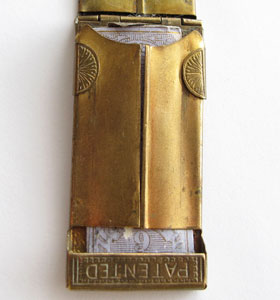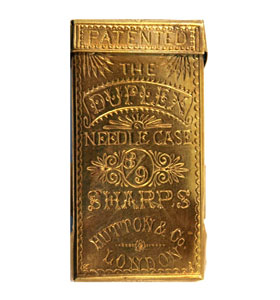Duplex

Needle Case

Patent
Design Details
Needle Case Type: |
Flat-Names |
Patent/Registered to: |
William Avery - Redditch Manufacturer |
Patent/Design Representation #: |
Mechanical Patent #: 1473 (Fig. 17) |
Patent/Design Registration Date: |
May 21, 1870 |
Location of Patent/Design Registration: |
British Library - Business and Intellectual Property Centre - London
|
Reference #: |
1870-1473 |
Dimensions: |
2.1 x 4.2 |
Material: |
Brass |
Name Variations: |
a) W. Avery & Son - Redditch
b) Hutton & Co - London (the only known photograph of this needle case is available in the booklet entitled Needle
Packet Holders: A Chronological Description by Jean Scott - revised 2012)
|
Other Variations: |
None |
Additional Photographs


Back and front with Avery signature detail


Open exterior and interior


Top and bottom interior detail


Back and front with Hutton signature (photo courtesy of Jean Scott)
Facts
A duplex item is one having two principle elements or parts. Although the term duplex is first known to have been used in the mid-16th
century, it became more prominent in the period 1810-1820. Deriving from the Latin duo meaning two and plicare, to fold, it was used to
describe things composed of two parts, twofold or of double use.

History

In Victorian times known as the Age of Invention, the term duplex was used to describe among other things a new improved oil lamp mechanism.
In 1865 Joseph Hinks of Birmingham patented the Duplex Lamp featuring a double burner with an extinguishing lever. His superior oil lamp was
so successful that the design was copied by other manufacturers when the patent had expired. Joseph Stearns, an American, invented the first
practical duplex telegraphy cable whilst serving as the President of the Franklin Telegraphy Company between 1869 and 1871. This enabled the
transmission of two telegraphy messages simultaneously. He sold his invention to the Western Union and Cable Companies after it had been used
successfully for Atlantic cable lines. He received royalties for its use from several European countries and several submarine cable
companies. Submarine cable lines were of great value to the British as it provided timely communication with the far flung reaches of its
Empire as well as commercial advantages for its shipping industry. By the end of the 19th century Britain dominated the North Atlantic lines
and owned and operated two thirds of the world’s cable. Usage of the term duplex to describe housing design did not occur until 1922.
Referring to a either a side by side or a double story structure to cater for two lots of occupants, it was in common usage mainly in the USA and
Australia. Click on the map below to see a larger version of it.

Miscellaneous
The Victorian era produced some truly useful inventions such as cars, trains, telephones, cameras and even flushing toilets but not all ideas
caught on. In 1843 the Utilities Designs Act enabled relatively cheap and simple copyright of people’s novel ideas compared to the very
expensive and complicated patent system that was the only option earlier. Julie Hall includes many of the more fanciful inventions in her
book “Inventions that didn’t Change the World” a compilation of registered designs she found in the files of the British National Archives.
Among these is the Duplex Hat, a design registered in 1873 by Messrs Herbert Lintott and Charles Smith. This is a design for a top hat that
can convert to a bowler. One can only wonder as the inventors probably did why such a practical invention didn’t take off.

Note: Right side panel text and photos provided by Lynda Herrod.


















